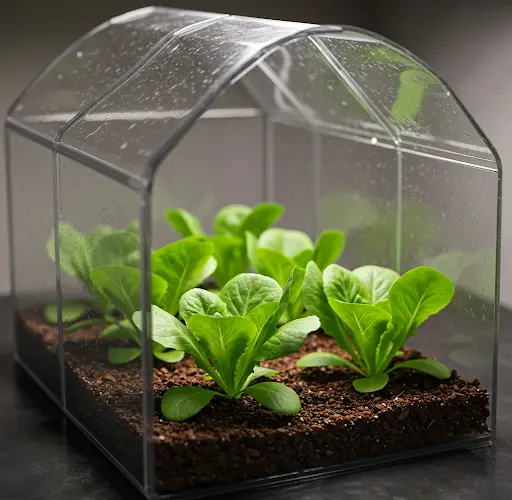Grow Lettuce in Winter Using a Mini Greenhouse Made from Recycled Tires
Lettuce is a cool-season crop that thrives in mild temperatures, but growing it in the winter months can be challenging in colder climates. However, with a little creativity and resourcefulness, you can grow fresh, crisp lettuce even during the coldest part of the year—by building a simple mini greenhouse using recycled tires.
This guide will walk you through how to build an eco-friendly mini greenhouse from old tires and how to use it to grow lettuce successfully throughout the winter season.
Why Grow Lettuce in Winter?
Lettuce is quick to grow, easy to harvest, and a staple in salads, wraps, and sandwiches. While most varieties grow best in spring and fall, they can also flourish in winter if protected from frost and extreme cold.
Winter gardening offers several benefits:
-
Fewer pests: Many insect pests are dormant in cold weather.
-
Better flavor: Lettuce grown in cooler conditions tends to be sweeter and crisper.
-
Fresh harvests: Avoid store-bought greens that may have been shipped long distances.
-
Sustainable practice: Growing food year-round reduces your environmental impact and supports self-sufficiency.
Reusing Tires to Create a Mini Greenhouse
Old tires are durable, widely available, and surprisingly useful in the garden. When stacked and covered, they can act as thermal insulators, capturing and storing heat from the sun. This makes them perfect for building small greenhouse structures that can protect tender greens like lettuce during the winter.
Materials You’ll Need
To build a tire-based mini greenhouse and grow lettuce in winter, you’ll need:
-
2 to 4 old car tires
-
Clear plastic sheeting or an old glass/acrylic window
-
Compost or organic soil
-
Lettuce seeds or seedlings (cold-tolerant varieties)
-
Mulch or straw (optional)
-
A small space with direct sunlight
Make sure your tires are clean and free of sharp debris or residues. Use standard passenger car tires—they’re lightweight, easy to handle, and stackable.
Step-by-Step: Build Your Mini Tire Greenhouse
1. Choose a Sunny Location
Pick a spot that receives 4–6 hours of direct sun daily, even in winter. South-facing areas work best for maximum exposure to sunlight.
2. Stack the Tires
Place one or two tires on top of each other to form a deep planting ring. For more insulation, stack up to three tires. Fill the inside with high-quality compost or organic garden soil.
The thick rubber walls of the tires will absorb sunlight during the day and release heat slowly at night, helping to maintain a stable temperature for your plants.
3. Sow Lettuce Seeds
Choose cold-tolerant lettuce varieties such as:
-
Winter Density
-
Arctic King
-
Rouge d’Hiver
-
Green Ice
-
Buttercrunch
Sow seeds about ¼ inch deep and lightly cover them with soil. Water gently to moisten the surface without over-saturating it.
4. Cover with Clear Plastic or Glass
After planting, cover the tire stack with a clear plastic sheet, old windowpane, or large transparent food container. This cover acts like a mini greenhouse, trapping warmth and moisture while protecting the plants from frost.
Secure the cover around the tire to prevent cold air from entering. If using plastic, make sure it’s slightly raised so air can circulate inside without touching the lettuce leaves.
Caring for Lettuce During Winter
1. Water Carefully
Water sparingly in winter. The soil should remain moist, not soggy. Overwatering can lead to root rot, especially in colder temperatures.
2. Ventilate on Warm Days
On sunny days, lift or slightly open the cover to allow excess heat and humidity to escape. This prevents fungal diseases and gives your plants a breath of fresh air.
3. Mulch for Extra Warmth
Add a thin layer of straw or leaf mulch around the base of the seedlings to retain moisture and further insulate the soil.
4. Monitor Growth
Lettuce grows more slowly in winter, but cold-tolerant varieties will still thrive. Thin the seedlings if needed to prevent overcrowding and ensure enough space for each plant to develop.
Harvesting Your Winter Lettuce
Lettuce is typically ready to harvest 30–60 days after sowing, depending on the variety and weather. In colder months, expect slower growth, but the leaves will be crisp and flavorful.
Harvest outer leaves as needed (cut-and-come-again method), or wait until the full head forms. Use clean scissors and avoid disturbing the roots to encourage continuous production.
Final Thoughts
Growing lettuce in winter may seem unlikely, but with a simple, low-cost setup using recycled tires and a clear cover, it becomes entirely achievable. This DIY mini greenhouse captures sunlight, retains warmth, and creates a microclimate where greens can flourish—even in cold conditions.
Using tires not only helps reduce waste but also provides an easy, reusable system to extend your gardening season. It’s a creative and practical solution for home gardeners looking to enjoy fresh, homegrown produce year-round.
Try it out this season—you may be surprised how well your lettuce grows, even when the rest of the garden sleeps.



